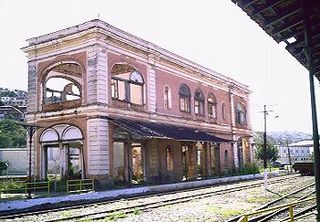
Manhuaçu is a municipality in Eastern Minas Gerais state, in Brazil. Its population was 91,169 (2020) and its area is 628 km2.

Além Paraíba is a city in the southeastern Zona da Mata region of Minas Gerais, Brazil. The name indicates its position on the far bank of the Rio Paraíba do Sul. It was known as São José d'Além Parahyba until 1923.

The War of the Emboabas was a conflict in colonial Brazil waged in 1706-1707 and 1708-1709 over newly discovered gold fields, which had set off a rush to the region between two generations of Portuguese settlers in the viceroyalty of Brazil - then the Captaincy of São Vicente. The discovery of gold set off a rush to the region, Paulistas asserted rights of discovery and non-Paulistas challenged their claims. Although the Portuguese crown sought more control in the area and the Paulistas sought protection of their claims, the Emboabas won. The crown re-assessed its position in the region and made administrative changes subsequently.

Agulhas Negras Peak is the fifth-highest mountain in Brazil, standing at 2,791 metres (9,157 ft) above sea level, making it one of the highest in the Brazilian Highlands. It is located in Itatiaia National Park, in the Mantiqueira range, on the border of the states of Rio de Janeiro and Minas Gerais. It is the highest point in the state of Rio de Janeiro, the third-highest in Minas Gerais, and the second-highest in the Mantiqueira range.
São José is Portuguese for Saint Joseph, and often refers to:
São Sebastião may refer to:

Leopoldina is a Brazilian municipality in the state of Minas Gerais. It belongs to the Zona da Mata mesoregion and it located 322 kilometers southeast of Belo Horizonte, the state capital. In 2022, its estimated population was 51 145 inhabitants, according to IBGE. Its territory covers an area of 943 km2.

Muriaé is a municipality in southeast Minas Gerais state, Brazil. It is located in the Zona da Mata region and its population in 2022 (IBGE) was approximately 104,108 inhabitants.

Caparaó National Park is a national park created in 1961 to protect the Caparaó Mountains, located on the border between Minas Gerais and Espírito Santo states in Brazil. Pico da Bandeira, one of the highest mountains in Brazil, is located there.

Oliveira is a Brazilian municipality in the state of Minas Gerais. It is located at latitude 20º41'47" south and longitude 44º49'38" west, at an altitude of 982 metres. It is located 165 kilometres at southwest from Belo Horizonte. Its estimated population was 41,181 according to the latest IBGE census.

Raul Soares is a Brazilian municipality located in the state of Minas Gerais. The city belongs to the mesoregion of Zona da Mata and extends to the microregion of Ponte Nova. As of 2020, the estimated population was 23,711.

The Roman Catholic Archdiocese of Mariana is an archdiocese based in the city of Mariana in the Brazilian state of Minas Gerais.

The Roman Catholic Diocese of Barra do Piraí–Volta Redonda is a diocese located in the cities of Barra do Piraí and Volta Redonda in the ecclesiastical province of São Sebastião do Rio de Janeiro in Brazil.

Gouveia is a Brazilian municipality located in the center of the state of Minas Gerais. Its population as of 2020 was 11,818 living in a total area of 874 km2. The city belongs to the statistical mesoregion of Jequitinhonha and to the statistical microregion of Diamantina. It became a municipality in 1953.

Passos is a Brazilian municipality located in the southwest of the state of Minas Gerais. Its population as of 2020 was 115,337 people living in a total area of 1,339 km2. The city belongs to the meso-region of Sul e Sudoeste de Minas and to the micro-region of Passos. It became a municipality in 1858.

Guaxupé is a Brazilian municipality located in the southwest of the state of Minas Gerais. Its estimated population in 2020 was 52,078 inhabitants living in a total area of 286 km2. The city belongs to the meso-region of Sul e Sudoeste de Minas and to the micro-region of São Sebastião do Paraíso. It became a municipality in 1837.

Mantena is a municipality in the state of Minas Gerais in the Southeast region o Brazil.
The MG-111 is a state highway located in the Brazilian state of Minas Gerais. Its total length is 183.6 km (114.1 mi), and its entire network is paved. Its route starts in Ipanema and ends at the border between the states of Minas Gerais and Rio de Janeiro.
















